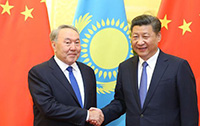Peru seen as a potential key provider of minerals
By YANG ZIMAN in Beijing (China Daily USA) Updated: 2015-05-23 05:24The largely untapped mineral industry in Peru offers wide opportunities for Chinese investment, say experts.
Peru's total mineral reserve ranks 7th in the world and 5th in Latin America, including zinc, tin, lead, gold, copper and silver.
"All mineral resources in Peru are open to investors," said Juan Carlos Capunay, Peruvian ambassador to China. "Twenty percent of land with mineral reserves in Peru is now ready for investment. We welcome foreign countries, especially Chinese enterprises, to invest here."
According to a report by Canada-based Fraser Institute, Peru ranks 30th in mineral investment appeal among 112 countries surveyed, second in Latin America only to Chile.
"Peru has a complete and well-functioning market economy. It is a politically stable and safe country to do business in," said Zhang Sengen, researcher of Latin American economy at the Chinese Academy of Social Sciences. "It is also in the Pacific Alliance together with Chile, Mexico and Colombia."
According to the agreement of Pacific Alliance, 92 percent of the commodities and services among the member countries enjoy zero tariffs. The remaining 8 percent enjoy various tariff cuts.
Peru is the third-largest copper producer in the world. Aluminum Corporation of China has invested in a copper exploitation project in Toromocho in Peru. The reservoir holds 12 million tons of copper, or 19 percent of China's entire copper reserves. The annual output is estimated at 220,000 tons, 18 percent of China's own annual output. The copper production is expected to last more than 30 years. It is so far the largest mineral project in Peru. Other minerals in the region include 290,000 tons of molybdenum and 10,500 tons of silver.
Before the opening of the project in 2013, Aluminum Corporation of China built a wastewater treatment facility at a cost of $50 million and other infrastructure including hospitals and schools for 1,000 households.
According to the statistics of Peru's national association of minerals, oil and energy, private investment in mineral industry in the country has increased by five times in the past decade. As the investment grows, poverty rate has dropped from 54.8 percent in 2009 to 23.9 percent in 2013. Commodities and services purchased by mineral companies amount to around $4.8 billion. Every job in the mineral industry can help to create nine jobs in other industries.
A total of 12 Chinese companies have invested in the mineral industry in Peru with more than 130 certificates for mineral exploitation.
Minerals and Mining Group Ltd, a subsidiary of Beijing-based China Minmetals Corp, purchased the Las Bambas copper project in Peru from the Swiss large commodity company Glencore International AG at $7 billion in 2014.
The purchase marks that China's investment in mineral industry in Peru has exceeded $19 billion, or 33 percent of the total investment in the industry.
Minerals contribute 61 percent of export volume and 14.4 percent of the country's GDP. Statistics show that only 0.32 percent of the country's land has been prospected and only 0.91 percent exploited.
According to a report by China Mining in 2014, an annual convention held by the Ministry of Land and Resources of China, Peru has made a lot of effort in its infrastructure construction, law and taxation policies to attract foreign investors in recent years.
The power price in the country is lower than Argentina, Mexico and Chile. The labor cost is relatively low as well. The cost in land prospect and feasibility research before production is reduced from the business tax of mineral enterprises. Investment in welfare properties for the workers can enjoy tax exemption.
yangziman@chinadaily.com.cn




